In the last couple years a rivalry erupted among companies in Europe aiming to be the fastest LSA-type aircraft*. I have previously reported on Porto Aviation and its fast-flying ways.
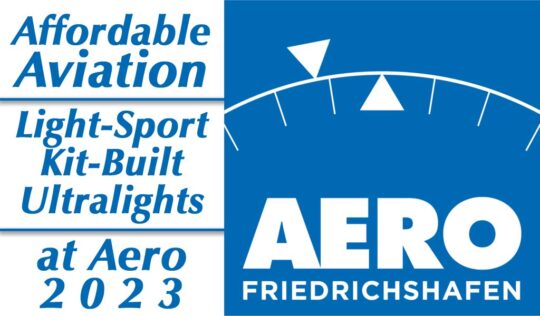 Setting aside the politics of FAI-recognized record flights, no question remains that designer Alberto Porto is determined to create a very fast-flying aircraft. Check this article with more about speed attempts and to see images of a fixed-gear version called Siren.
Setting aside the politics of FAI-recognized record flights, no question remains that designer Alberto Porto is determined to create a very fast-flying aircraft. Check this article with more about speed attempts and to see images of a fixed-gear version called Siren.
Gear up with an adjustable prop and flown at common cruise altitudes, it’s clear that Superveloce lives up to its name.
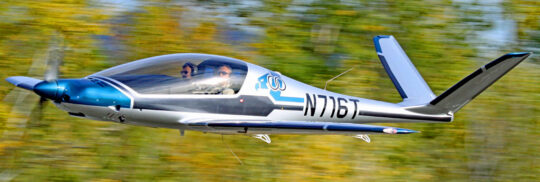 What could the typical pilot expect while flying Superveloce? Porto Aviation lists the cruise speed at 75% power from Rotax’s 915iS at 200 knots true airspeed at 9,000 feet. Compared to other LSA I have examined, this tops the list (although some other fast designs aren’t too far behind).
What could the typical pilot expect while flying Superveloce? Porto Aviation lists the cruise speed at 75% power from Rotax’s 915iS at 200 knots true airspeed at 9,000 feet. Compared to other LSA I have examined, this tops the list (although some other fast designs aren’t too far behind).
Porto Aviation, previously quartered in Switzerland, is now a bit further south in Italy. Flying across his former country and the large Bodensee lake to Friedrichshafen, about 200 miles, took Porto just over one hour in the machine seen in the nearby images. By car this would take over four hours. For a large country like America, Superveloce can get you around fast. It also has an impressive range. No wonder Yankees are buyers.
How Fast Is Superveloce?
OK, it’s fast but…
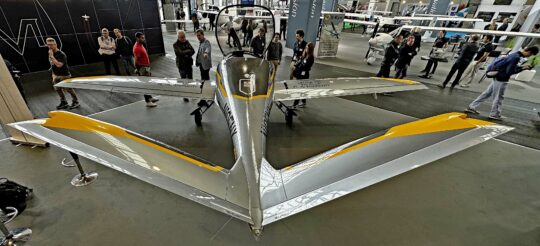
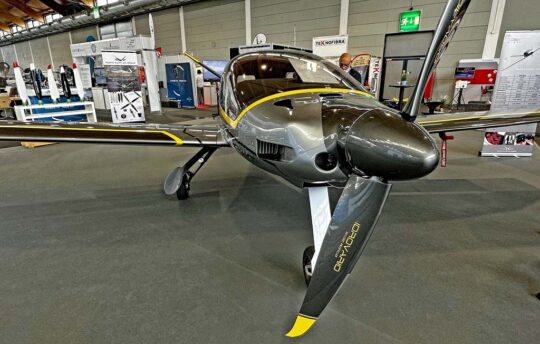
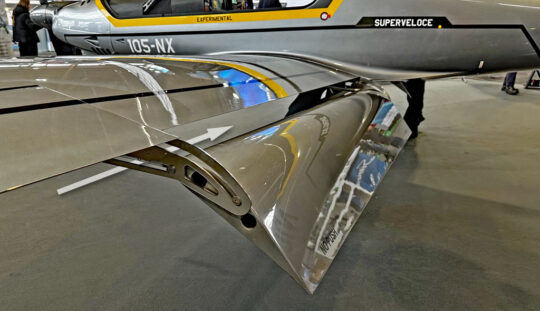
Fowler flaps extend far enough to allow generous airflow (arrow), greatly adding to its slow-speed flight qualities.
With its smaller “speed wing,” can Superveloce stay within LSA regs? — You might rightfully wonder about that but although stall rose six knots from the earlier Risen model, it still claims a best-flaps stall at 43 knots indicated, which is within current LSA parameters and safely below the 50-knot stall speed expected under Mosaic regulations, though we have not yet seen FAA’s Notice of Proposed Rule Making (NPRM) to verify this number. A key reason Superveloce can achieve this sane stall speed from a speed wing is the brilliant execution of Fowler flaps (image with arrow).
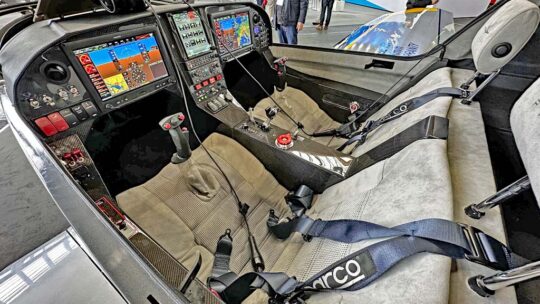
For still more on Superveloce and its speedy ways, see this article from 2021.
Looking Back;
Looking Forward
At the beginning of 2010 Alberto Porto and his partners started construction of the first Risen prototype. Two years later on a sunny Swiss morning in March 2012, the Risen aircraft made its maiden flight.
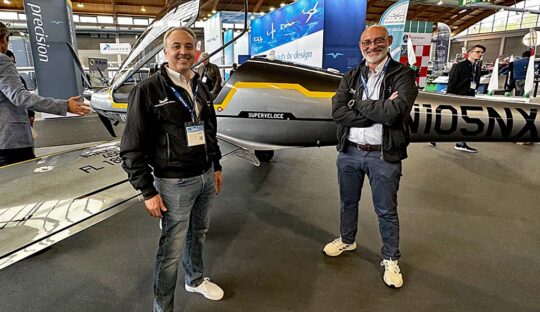
Alberto Porto (L) and his partner, Danilo Parlatano were all smiles at Aero 2023. Alberto flew this aircraft from Italy to Friedrichshafen in just over one hour.
After work to refine the model and to prepare for production the first aircraft ready for customers was unveiled on April 15th, 2015 at Aero. My video below was recorded at this debut.
Eight years later, this project is mature with 25 flying, 10 of which are in the United States and interest is steadily growing.
Now that his airplane-building company has satisfied more than two dozen customers, Alberto is planning ahead. He is actively supporting American builders — by in-person visits on some occasions.
As Mosaic arrives and he can meet relevant ASTM standards, Alberto wants to establish a U.S. operation, possibly doing final assembly or more as the market develops.
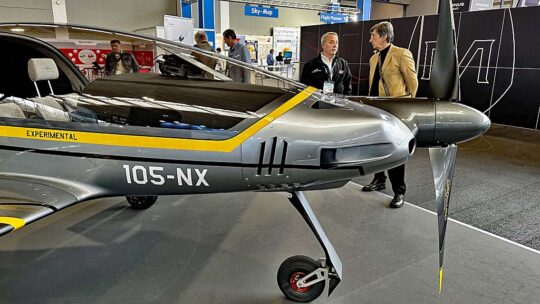
Superveloce deceives the eye with this apparently tiny engine compartment. This is not electric; a Rotax 915iS is hidden under this unique cowling. The big canopy power opens by a press of a switch, as Porto repeatedly demonstrated to Aero attendees.
If speed is your thing, wouldn’t “superfast” be even better?
ARTICLE LINKS:
- Porto Aviation, all content on this website
- Porto Aviation, factory website
- Aero Friedrichshafen, show website
- More speed specifications, see table below
Years ago, when the project was brand new, I recorded this interview with developer Alberto Porto as he first displayed his speed machine to visitors at Aero 2015. Showing how popular this flying machine proved to be, the video has been viewed almost 700,000 times. It describes the beginning of Risen, which has now lead to Superveloce.
* Superveloce is LSA-like but with features such as retractable gear and higher cruise speeds, this aircraft does not qualify as a present-day LSA.



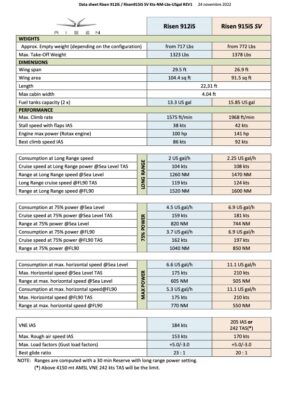
Is the stall speed clean at or above 54 knots?
The specifications don’t list clean stall (VS1) but given they list best-flaps stall at 42 knots (on the 915iS-powered SuperVeloce), it seems possible clean stall could be 54 knots or less. We’ll have to wait until Porto makes their declaration for a final answer.
Is Porto Aviation still in business?
The email sender on the Risen website is broken and I’m having trouble getting a response from the published email addresses.
Anyone know if they are planning on a variant with the 916?
Did you try? info@flyrisen.com
Howdy Dan,
Yep, gave that email address a try.
Haven’t heard anything back
Ok. I’m confused. You say “However, when Mosaic is released, based on what we expect at this time, Superveloce could qualify. We do expect retractable gear, in-flight adjustable props, higher stall, and faster speeds, although we do not yet know if Sport Pilots will be allowed to operate this aircraft with that certificate.“
If this plane fits into Mosaic but can’t be flown by Sport Pilots, then what is the advantage of Mosaic to a Sport Pilot. I don’t understand this. Can you clarify?
It is an easy misunderstanding. FAA is divided into groups. One of them handles aircraft certification. They are the ones working on the Mosaic airplanes about which I write. Another group handles pilot certification and operations. They have said much less about where they are headed. It is possible that we will have a new LSA-like aircraft that cannot be flown by a Sport Pilot… at least before getting a logbook endorsement for the “upgraded“ aircraft.
That certainly isn’t what we were all lead to believe by the original hype and fanfare by EAA and AOPA. If that is the case, what is the point? It will not make more planes available for the sport pilot, only for the private, which already has an abundance of options. So why refer to them as any type of Light Sport Aircraft? Just call them new airplanes, and leave the light sport part out….
I understand, Rick. I mainly attempted to clarify that Sport Pilot (the human certification) and Light-Sport (the aircraft) are not handled the same. However, I DO believe that eventually a Sport Pilot may get endorsed to fly a larger aircraft if he/she wishes. We lack direction about pilot privileges. We know more about the aircraft side. Fortunately, nothing really changes about our current 1,320-pound LSA accept more privileges are being offered.Those designs can keep on flying.
I continue to think of Light-Sport Aircraft weighing as much as 3,500 pounds as in-the-LSA-category because of their means of creation, using industry consensus standards. The industry gets a lot of say in this process and it has moved development along quicker than expected. On the pilot side… uh, not so much.
The key words here are “eventually” and “may”. When the Sport Pilot rules were first adopted the pilot certification and the aircraft consensus standards were both written at the same time. That makes sense, and both were promoted by EAA, AOPA, and the industry. Not the FAA. What doesn’t make sense is that now the EAA, AOPA, and the industry seem to only be pushing the aircraft standards. It seems that ever since basic med all three groups have left the sport pilot in the dust. (On another topic, is Basic Med really safer than Sport Pilot? I know guys who let their medical expirr because they knew they had problems and wouldnt pass. Now they are
flying under Basic Med. Heck, I will consult with my personal physician once a year if it means I could fly the same aircraft. I’m more healthy than most of them! – But I digress) Sorry to keep replying, this will be my last on this subject but it is a very sore point with a lot of sport pilots. Both standards should be changed together. Nonetheless, You are doing a great job keeping us informed, even though we are disappointed in the certification progress. Thank you.
Believe me, you are not alone in wishing we could get more response out of the Flight Standards group that determines pilot certification and operations… but little has been forthcoming. So, we focus on what we do know: aircraft. Hopefully, soon the mystery will be lifted (for better or worse).
Oh! I had one too many biscuits for breakfast, don’t think the wedge will hold the bulge… , maybe the sprawl.
Stunningly beautiful aircraft. And I thought Lancair had it all. If you have the money and the capability to fly it, are you one to even care about LSA?
These aircraft excite the imagination but as a rule they are only safe in the hands of a few. Think deadly vicious stalls and twitchy handling.
It is said to have reasonable handling and its impressive flaps allow a low stall speed. However, you make a valid point about performance aircraft.
It sounds like it could be a fantastic travel machine – if it has anywhere for bags. How big IS that hat rack?
You can load up to 30 kilograms (66 pounds) comfortably.